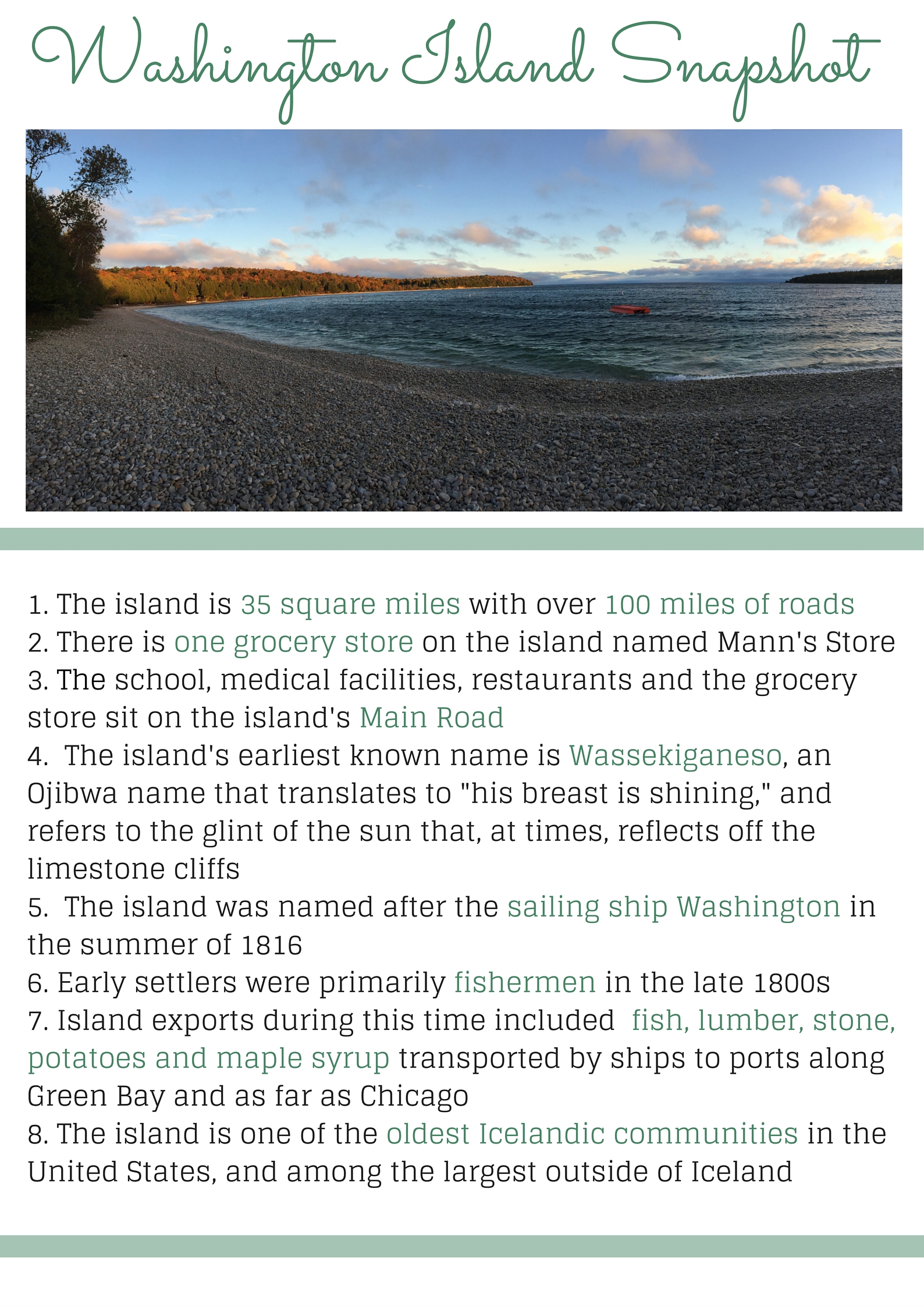Wisconsin’s Lavender Isle
Edgar Anderson looks out the window of the red barn to admire the rows and rows of lavender plants on remote Washington Island. The view is his wife, Martine’s, dream come to life. The sky is vast on the crisp, autumn morning, and hints of blue are struggling to show between the ominous grey clouds. Several pristine, white benches dot the green field, and with the summer harvest season ended, the once vibrant purple plants are now little green bushes. The changing colors of the leaves, dotting the vast green landscape with shades of yellow and orange, make up for the absence of vibrancy that the lavender plants provide during their harvesting season. Inside the barn at Fragrant Isle Lavender Farm and Shop, the scent of lavender envelops guests, who are greeted by a delightful array of cookbooks, lavender plants, and countless culinary and bath lavender products. Outside, the quietness and the peace is all-encompassing — there’s not another soul nor another home in sight.
Washington Island is remote, only accessible via ferry or local airport, and with only about 700 permanent residents. Life for these residents is quite far removed. There are no chain stores on the island and only one grocery store, Mann’s Store on Main Road. In the winter months, with only two freight boats per week bringing over a selection of groceries, the store often runs out of goods, and residents have to adjust their meals accordingly. An island that once sustained itself on fishing and farming is now primarily known for its tourism, the main industry on the island. Yet, the Andersons are bringing back the tradition of farming, in a fresh and unique way, with lavender. Fragrant Isle Lavender Farm and Shop is the embodiment of a dream on sleepy, beautiful Washington Island, a farm amid the bustling tourism businesses, and it is becoming a tourist destination in its own right.
Herb and Marianne Gibson, owners of Gibson’s West Harbor Resort, count on the tourism industry on Washington Island. They too enjoy the stillness of the island, being surrounded by nature and accommodating their guests, many of whom come back year after year and become extended family.
While tourism is now the main industry on the island, before resorts existed there, farming and fishing encouraged people to stay in the first place, Marianne Gibson says. There was also a period where lumber businesses flourished on the island, and in the 1950s and 1960s, a large potato farm employed many people, Herb Gibson says. Cherry farms, which are still prevalent in Door County, also used to exist on the island. Thus, Fragrant Isle is appropriately named, a delightful return to farming on Washington Island.
There’s something about the island that has always attracted a small, but dedicated group of people. Herb has lived on the island since he was two years old, and Marianne has never lived anywhere else. The two raised their family of six children on the island, four of whom went back to live on the island after college.
Marianne’s daughter, Sarah Gibson, who graduated from the University of Wisconsin-Eau Claire, chose to return to the island after college.
“I loved [growing up on the island]. It’s very unique,” Sarah says. “Every week in the summer, we had a new group of kids to play with.”
While she graduated high school in a class of eight, one of her sisters graduated with 13 other students, and another one only had five other students. In June 2015, the high school only graduated one student.
Washington Island is one of a string of islands that stretch across the entrance from Green Bay in Wisconsin’s Door Peninsula to the Garden Peninsula in Michigan. The narrow passage that connects Lake Michigan and Green Bay is only six miles wide, and has very turbulent currents, evident on the ferry to and from the island. These currents, combined with the strong, sudden winds of the Great Lakes, creates a frightening experience on the ferry, as the boat ceaselessly and dramatically rocks back and forth, and water constantly splashes onto the boat. There are many stories of old Indian war parties being drowned in the area. The Indians called the passage the “Door to Death,” which early French explorers then translated into Port des Morts, the “Death’s Door” of today. In the fall of 1872, over 100 large vessels were stranded or damaged.
In 1879, a Danish merchant by the last name Wickman persuaded four bachelors from Iceland to move to the island. They came and established the second-oldest Icelandic settlement in America, and among the largest outside of Iceland itself.
“I’ve been told through my life that Icelandic people found the island, and the landscape reminded them of the landscape at home, so they made this their new home,” says Mark Udovich, a Chicago resident who owns a second home on the island. His grandparents were born on the island, and his great-grandparents emigrated there from Denmark.
The Andersons are much newer to the island, having moved there just five years ago, once they retired from fast-paced, successful careers. Edgar was born in Honduras and Martine was born in the south of France. The two met in Miami, where Edgar was in graduate school for architecture at University of Miami and where Martine worked at the time. Edgar proceeded to lead McDonald’s corporations in construction, equipment and engineering for global development, while Martine had a successful career in haute couture for Saks Fifth Avenue and Neiman Marcus. The two moved to Chicago for Edgar’s career, and traveled across the globe for their work.
Martine grew up in the south of France, surrounded by lavender fields and farms, dreaming of owning her own lavender farm one day. When they moved to Washington Island after retirement five years ago, Edgar began doing research, conducting climate and soil studies and experimenting with the growth of different lavender varieties to see if it would be possible to grow lavender there. After it was evident that lavender could be grown on the island, the two went on to establish the farm with Helene Meyer, a retired industrial psychologist.
The Andersons now grow both culinary lavender, which consists mainly of English varieties, and aromatic types of lavender, which is mainly of French varieties. They bloom in July and August, purposefully done so the vibrant purple fields are alive during tourist season. They infuse lavender in culinary products, ice creams, chocolates, caramels, pastries and even sodas.
The transition from city life in Chicago to living on Washington Island was “not a bad thing,” according to Edgar.
“We’re as far as possible from an airport that you can get and I was tired of traveling,” Edgar says. “It’s a nice place to be — very quiet. We moved here, we remodeled our house and when we we’re done with that, we started tinkering with the idea of lavender.”
The couple also visited North and South Carolina and Tennessee when deciding where to retire, but were most attracted to Door County and Washington Island. The couple vacationed in the Fish Creek area and in Door County for many years, eventually visiting Washington Island. They liked the island and bought a home there.
“It wasn’t premeditated, it’s something we discovered,” Edgar says. “It was not a quick decision — it was something that we really analyzed because we weren’t sure we could live in a cold place like this.”
There isn’t one traffic light on the island, and the Andersons don’t miss standing in two-hour traffic in the middle of highways. If anything, the couple sometimes misses the variety of food available in a big city, but for the most part they enjoy life on the island.
“We like it and we get out,” Edgar says. “We simply take a weekend and go visit friends in Appleton or Chicago, and we get our fix and then we come back. It’s not for everybody … because it is remote and it is quiet.”
The two major challenges Edgar and Martine face on the farm are the climate and labor. Because of the island’s small population, it’s hard to find help.
“We are hands on, Martine and I,” Edgar says.
There is no typical day for the Andersons, as the demands of running their business vary.
“The island is very informal and fires appear here and there … fires meaning problems,” Edgar says. “But I try to keep focused on where I want to go and make sure that we accomplish those goals.”
The Internet service is extremely slow, and the cash register system occasionally goes down, sometimes when the shop is busy — an unwelcome obstacle that Edgar has had to deal with.
There’s a stark difference on the island as the seasons change, and with the island’s population increasing to a few thousand in the summer, permanent residents are much busier during this time.
The lavender farm and shop is only open to the public from May through the end of October, but they have a “very robust website” according to Edgar, which also does very well in sales year-round. They also host a lavender festival in July.
“We just had our first one this summer on [July] 24, and it was very successful, thousands of people came,” Edgar says. “The ferry line commented it was the busiest day they’ve ever had. The fields were spectacular, the plants were in full bloom and we had a major success. That took a lot of preparation and effort to make it happen.”
In the winter, when the lake freezes over, there are only two ferries per day, and island residents have to plan further in advance, sometimes making an appointment, if they want to get off the island. The ferry, which is able to hold about 18 cars, has to break through the ice to cross.
The Andersons and Helene are nonetheless busy through the cold months as well, preparing for the summer, creating lavender products and selling products on their website.
“The island is starting to get very quiet and people who live on the island sort of go ‘ahhh’ and take a deep breath when summer is over. They get the island back to themselves,” says Julie Imig, marketing director of Fragrant Isle and a seasonal resident who calls Appleton home during the winter months.
Edgar and Martine are concerned with the look of their products, as it is their goal to sell them in retail stores around the country — thus, why the packaging is important. Edgar describes the lavender farm and shop as agritourism, a growing industry in Wisconsin. In agritourism, tourists want to go to the farm, experience it and buy the products.
The residents of this isolated, obscure island are passionate about the businesses they run, keeping them occupied amid the remoteness and the quietness. For Edgar and Martine, despite their remote location, their products are sold throughout the state. Though it’s still a relatively new business, they receive media attention across the region, with a television feature on Travel Wisconsin and a feature in the Chicago Tribune coming up in the spring. For Herb and Marianne, their guests come from all over the country and often outside of the country as well, keeping them connected to the rest of the world.
“We are often too busy to notice how quiet and isolated the island is,” Edgar says.



